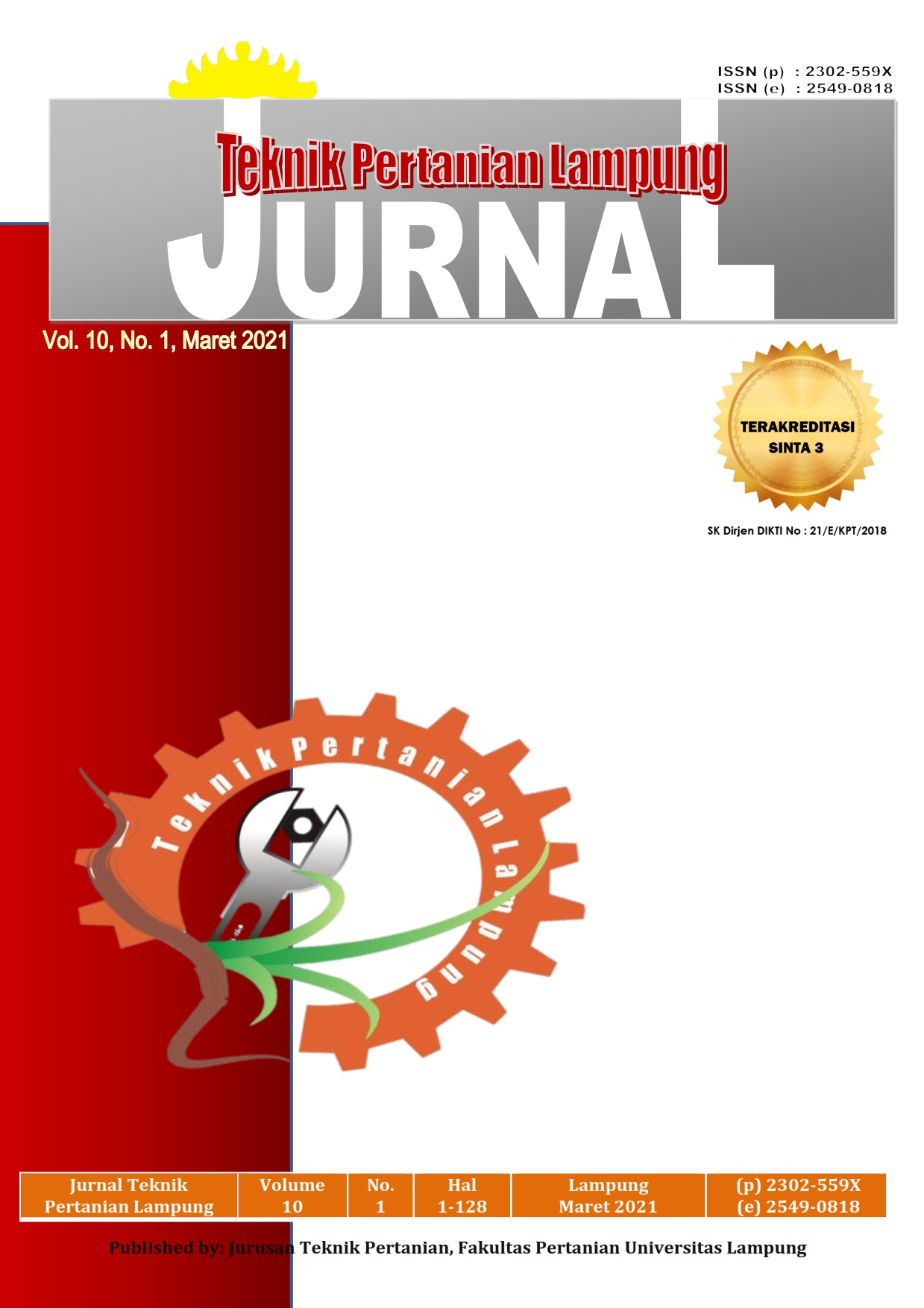APLIKASI UV SPECTROSCOPY DAN METODE SIMCA UNTUK KLASIFIKASI KOPI LIBERIKA TUNGKAL JAMBI DAN KOPI LIBERIKA PROBOLINGGO
DOI:
https://doi.org/10.23960/jtep-l.v10i1.49-56Abstract
Tungkal Composite Jambi Liberika Coffee is one of the top qualities of Indonesian coffees that has received a geographic indication certificate (IGs). With its limited production and high prices, currently Tungkal Jambi Liberika coffee is one of the coffees that is prone to being counterfeited. The counterfeiting of Tungkal Jambi Liberika coffee is increasingly difficult to identify, especially in the form of ground roasted coffee. This study evaluated the potential application of UV spectroscopy technology to classify Tungkal Jambi Liberika coffee (with geographic indications) and normal Probolinggo Liberika coffee (non- geographic indications). A total of 120 samples for each Liberika coffee were prepared weighing 1 gram for each sample. Spectra measurements were carried out in the form of a coffee solution. Spectral data were taken using a UV-visible spectrometer with a wavelength interval of 200-400 nm (Genesys 10S UV-Vis, Thermo Scientific, USA). By using the average transformed spectra in the 250-350 nm interval, the differences between the two types of Liberika coffee can be clearly seen, especially at some wavelength peaks, namely 270 nm, 300 nm, 315 nm and 346 nm. The classification accuracy obtained for the SIMCA classification is 100% for both Tungkal Jambi Liberika and Probolinggo Liberika coffee.
Keywords: authentication, classification accuracy, Tungkal Jambi Liberika coffee, SIMCA, UV Spectroscopy
References
Aboulwafa, M. M., Youssef, F. S., Gad, H. A., Sarker, S. D., Nahar, L., Al-Azizi, M. M., & Ashour, M. L. (2019). Authentication and discrimination of green tea samples using UV–vis, FTIR and HPLC techniques coupled with chemometrics analysis. Journal of Pharmaceutical and Biomedical Analysis, 164, 653–658. https://doi.org/10.1016/j.jpba.2018.11.036
Baqueta, M. R., Coqueiro, A., Março, P. H., & Valderrama, P. (2021). Multivariate classification for the direct determination of cup profile in coffee blends via handheld near-infrared spectroscopy. Talanta, 222, 121526. https://doi.org/10.1016/j.talanta.2020.121526
Dankowska, A., DomagaÅ‚a, A., & Kowalewski, W. (2017). Quantification of Coffea arabica and Coffea canephora var. robusta concentration in blends by means of synchronous fluorescence and UV-Vis spectroscopies. Talanta, 172, 215–220. https://doi.org/10.1016/j.talanta.2017.05.036
Davis, A. P., Tosh, J., Ruch, N., & Fay, M. F. (2011). Growing coffee: Psilanthus (Rubiaceae) subsumed on the basis of molecular and morphological data; implications for the size, morphology, distribution and evolutionary history of Coffea. Botanical Journal of the Linnean Society, 167(4), 357–377. https://doi.org/10.1111/j.1095-8339.2011.01177.x
DGIP. (2013). Buku Persyaratan Indikasi Geografis Masyarakat Perlindungan Indikasi Geografis (MPIG) Kopi Tungkal Jambi.
Keidel, A., Von Stetten, D., Rodrigues, C., Máguas, C., & Hildebrandt, P. (2010). Discrimination of green arabica and Robusta coffee beans by Raman spectroscopy. Journal of Agricultural and Food Chemistry, 58(21), 11187–11192. https://doi.org/10.1021/jf101999c
Meza-Márquez, O. G., Gallardo-Velázquez, T., & Osorio-Revilla, G. (2010). Application of mid-infrared spectroscopy with multivariate analysis and soft independent modeling of class analogies (SIMCA) for the detection of adulterants in minced beef. Meat Science, 86(2), 511–519. https://doi.org/10.1016/j.meatsci.2010.05.044
Pomerantsev, A. L., & Rodionova, O. Y. (2014). On the type II error in SIMCA method. Journal of Chemometrics, 28(6), 518–522. https://doi.org/10.1002/cem.2610
Pomerantsev, A. L., & Rodionova, O. Y. (2020). Popular decision rules in SIMCA: Critical review. Journal of Chemometrics, 34(8), 1–14. https://doi.org/10.1002/cem.3250
Roshan, A. R. A., Gad, H. A., El-Ahmady, S. H., Khanbash, M. S., Abou-Shoer, M. I., & Al-Azizi, M. M. (2013). Authentication of monofloral yemeni sidr honey using ultraviolet spectroscopy and chemometric analysis. Journal of Agricultural and Food Chemistry, 61(32), 7722–7729. https://doi.org/10.1021/jf402280y
Santos, K. M., Moura, M. F. V., Azevedo, F. G., Lima, K. M. G., Raimundo, I. M., & Pasquini, C. (2012). Classification of Brazilian Coffee Using Near-Infrared Spectroscopy and Multivariate Calibration. Analytical Letters, 45(7), 774–781. https://doi.org/10.1080/00032719.2011.653905
Sianipar, H. (2017). Keragaman Genetik Populasi Kopi Liberika (Coffea Liberica W. Bull Ex. Hiern) Di Kecamatan Betara Berdasarkan Karakter Buah Dan Biji. Universitas Jambi.
Suhandy, D., & Yulia, M. (2019). Classification of Ground Roasted Kalosi and Toraja Specialty Coffees using UV-Visible Spectroscopy and PLS-DA Method. Jurnal Ilmu Pertanian Indonesia, 24(1), 73–81. https://doi.org/10.18343/jipi.24.1.73
Suhandy, D., & Yulia, M. (2018). Discrimination of several Indonesian specialty coffees using Fluorescence Spectroscopy combined with SIMCA method. IOP Conference Series: Materials Science and Engineering, 334(1). https://doi.org/10.1088/1757-899X/334/1/012059
Suhandy, Diding, & Yulia, M. (2017). Peaberry coffee discrimination using UV-visible spectroscopy combined with SIMCA and PLS-DA. International Journal of Food Properties, 20, S331–S339. https://doi.org/10.1080/10942912.2017.1296861
Yulia, M., Asnaning, A. R., & Suhandy, D. (2018). The Classification of Ground Roasted Decaffeinated Coffee Using UV-VIS Spectroscopy and SIMCA Method. IOP Conference Series: Earth and Environmental Science, 147(1). https://doi.org/10.1088/1755-1315/147/1/012010
Yulia, M., & Suhandy, D. (2018). Identification of fresh and expired ground roasted robusta coffee using UV-visible spectroscopy and chemometrics. MATEC Web of Conferences, 197. https://doi.org/10.1051/matecconf/201819709003
Downloads
Published
Issue
Section
License
- Authors who publish with this journal agree to the following terms:
- Authors retain copyright and grant the journal right of first publication with the work simultaneously licensed under a Creative Commons Attribution-ShareAlike 4.0 International Lice that allows others to share the work with an acknowledgement of the work's authorship and initial publication in this journal.
- Authors are able to enter into separate, additional contractual arrangements for the non-exclusive distribution of the journal's published version of the work (e.g., post it to an institutional repository or publish it in a book), with an acknowledgement of its initial publication in this journal.
- Authors are permitted and encouraged to post their work online (e.g., in institutional repositories or on their website) prior to and during the submission process, as it can lead to productive exchanges, as well as earlier and greater citation of published work (See The Effect of Open Access).
Jurnal Teknik Pertanian Lampung

JTEPL is licensed under a Creative Commons Attribution-ShareAlike 4.0 International License.

